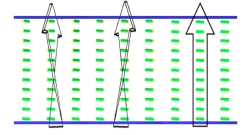This new ultrathin, energy-efficient 3D LCD display technology could be in your future TV or flexible e-book
October 24, 2014

In this concept of a LCD display, light is twisted in different directions to make the image appear three-dimensional (credit: Abhishek Kumar Srivastava)
Researchers from the Hong Kong University of Science and Technology have invented an ultra-thin LCD screen capable of displaying images without a sustained power source and in 3D, making it a compact, energy-efficient way to display visual information.
In a traditional liquid crystal display (LCD), liquid crystal molecules are sandwiched between polarized glass plates. Electrodes pass current through the apparatus, influencing the orientation of the liquid crystals inside and manipulating the way they interact with the polarized light. The light and dark sections of the readout display are controlled by the amount of current flowing into them.
The new displays use an optically rewritable liquid crystal display (ORWLCD) design, so they don’t require electrodes, making the screen thinner and decreasing its energy requirements. Once an image is “painted” on the screen with light, no power is required to keep it there for several years. These “bi-stable” displays draw power only when the image is changed, so they are especially useful for applications where a screen displays a static image for most of the time, such as e-book readers or battery status monitors for electronic devices.
The thin profile and minimal energy requirements of devices could also make it useful in flexible displays or as a security measure on credit cards.
A better 3D system
The researchers also engineered ORWLCD to display images in 3D. Real-world objects appear three-dimensional because the separation between your left eye and your right creates perspective. 3D movies replicate this phenomenon on a flat screen by merging two films shot from slightly different angles, and the glasses that you wear during the film selectively filter the light, allowing one view to reach your left eye and another to fall on your right to create a three-dimensional image.
However, instead of displaying multiple images on separate panels and carefully aligning them — a tedious and time-consuming process — the researchers create the illusion of depth from a single image by altering the polarization of the light passing through the display. They divide the image into three zones: one in which the light is twisted 45 degrees to the left, another in which it is twisted 45 degrees to the right, and a third in which it is unmodified. When passed through a special filter, the light from the three zones is polarized in different directions.
Polarized glasses worn by the viewer then make the image appear three-dimensional by providing a different view to each eye.
This technology currently displays images only in grayscale and can’t refresh them fast enough to show a film, said researcher Abhishek Srivastava, one of the authors of a paper published Wednesday (Oct. 22) in a paper in The Optical Society’s (OSA) journal Optics Letters. But Srivastava and his colleagues says they are in the process of optimizing their device for consumer use by adding color capabilities and improving the refresh rate.
Abstract of Optically rewritable 3D liquid crystal displays
Optically rewritable liquid crystal display (ORWLCD) is a concept based on the optically addressed bi-stable display that does not need any power to hold the image after being uploaded. Recently, the demand for the 3D image display has increased enormously. Several attempts have been made to achieve 3D image on the ORWLCD, but all of them involve high complexity for image processing on both hardware and software levels. In this Letter, we disclose a concept for the 3D-ORWLCD by dividing the given image in three parts with different optic axis. A quarter-wave plate is placed on the top of the ORWLCD to modify the emerging light from different domains of the image in different manner. Thereafter, Polaroid glasses can be used to visualize the 3D image. The 3D image can be refreshed, on the 3D-ORWLCD, in one-step with proper ORWLCD printer and image processing, and therefore, with easy image refreshing and good image quality, such displays can be applied for many applications viz. 3D bi-stable display, security elements, etc.